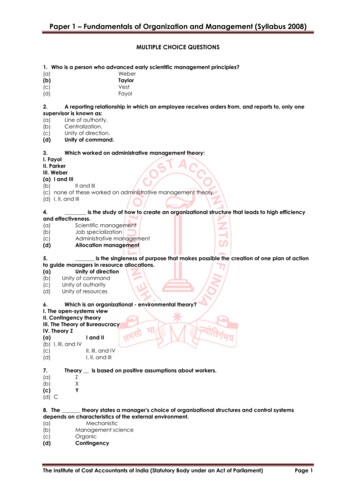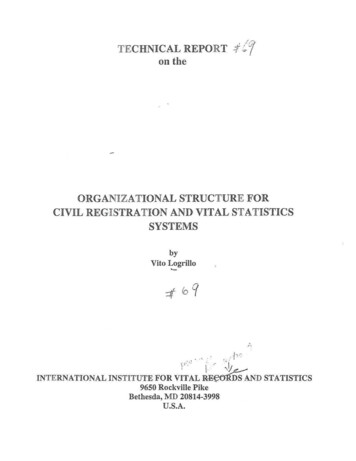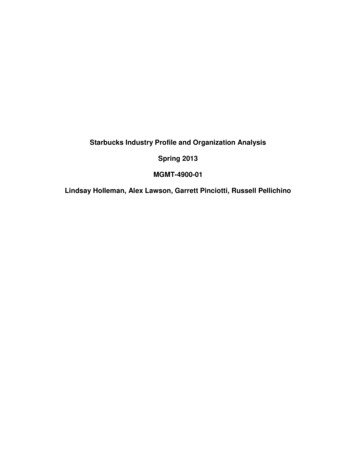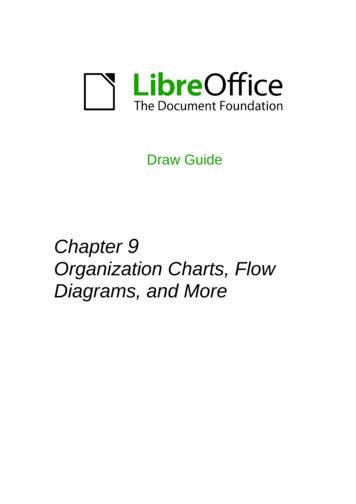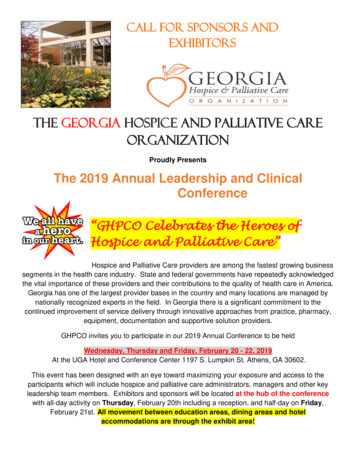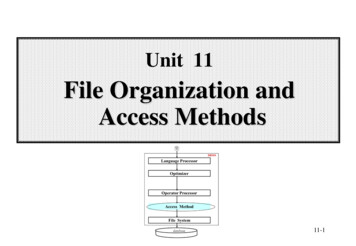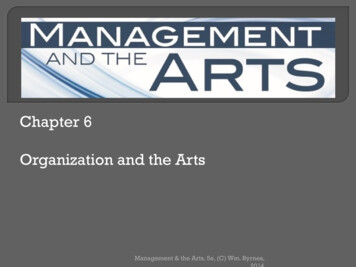
Transcription
Chapter 6Organization and the ArtsManagement & the Arts, 5e, (C) Wm. Byrnes,
Chapter OverviewIn order to effectively carry out the mission and goals of an artsorganization the alignment of the people, plans, budgets, and processesneeds to carefully considered by the arts manager. Organizationalstructure should be stable, but not rigid. Formal and informal systems oforganization can develop inside and organization and the cumulativeimpact of people and projects interacting helps produce an overall socialsystem called an organizational culture. This chapter focuses on: Organizing and Organizational Design in the Arts Organizational Charts and the Story the Tell Structure and Strategy Building Positive Organizational CulturesManagement & the Arts, 5e, (C) Wm. Byrnes, 2014
Organizing and Organizational Design in the ArtsBenefits of Organizing1. Helping to make clear who is supposed to do what2. Establishing who is in charge of whom3. Defining the appropriate channels of communication4. Helping to clarify where resources need to be applied to meetobjectivesThe process of presenting performances for the public or opening anexhibit at a specific date, time, and place requires detailed coordinationacross multiple work areas in an arts organization. Each art form over timehas developed processes that best align with the kind of work being donein preparing the work that will be shared with the public.Management & the Arts, 5e, (C) Wm. Byrnes, 2014
Organizing and Organizational Design in the ArtsArts organizations are open systems and the organization design reflectsexternal and internal influencesThe addition of atouring program toa hypothetical artsorganization isreflected inchanges to theorganizationalchart. Changes arealso reflected instaff reporting andsupervisorycapacities.Management & the Arts, 5e, (C) Wm. Byrnes, 2014
Organizational ChartsOrganizational Structure – A system of tasks, reporting relationships, andcommunication linkages. An effective organizational chart will help yougrasp the formal structure of an organization.The key elements of an organization chart should communicateinclude:A. Division of workB. Supervisory relationshipC. Lines of communicationD. Subunits, departments, or Work GroupsE. Levels of managementManagement & the Arts, 5e, (C) Wm. Byrnes, 2014
Elements of anOrganizationalChartA. Division of Work(e.g. developmentand marketing,curating, operations)B. Supervisoryrelationship (verticallines)C. Lines ofcommunication(horizontal & vertical)
Elements of anOrganizationalChartD. Subunits,Departments, or WorkGroups (e.g. Subunitssuch as the museum shop,visitor services & securityguards and custodialservices, etc.)
Elements of anOrganizationalChartE. Levels ofManagement *This example is of a relatively“flat” organizational structureRed Upper level ofmanagement positions, e.g.“directors”Blue Middle managementpositions – [Note: Exec Assistantcould be a staff support position}Yellow Lower levelmanagement and/or supportstaff positions* Board positions are not factored intothe organization structure since they arethe oversight body and not involved inday-to-day operations.
Informal Organizational StructuresThese exist in all organizations and often are the truer picture of howpeople work together. For example, in the National Museum of Wildlife Artthe marketing and development staff often work directly with otherdepartments and do not go through the chain of command (i.e. Director ofDevelopment and Marketing.It’s entirelypossible that theAssist. Dir. ofDevelopment andthe MarketingCoordinator willestablish their owncommunicationand workingnetwork with theorganization inorder to do theirjobs.
Other Key Concepts in Organizational DesignStructure & StrategyIf you have are an arts organization with a growth strategy, then it makessense you would be adding more staff in marketing, website support,support for increased social media interaction, and sales staff . With morepeople comes the need for more supervision, monitoring, reporting andoverall communication. With a marketing and sales growth strategy comesenhanced technology to support research, sales tracking and enhancedcustomer relation management (CRM) systems.Horizontal and Vertical Coordination of Staff WorkSmall arts organization, often under-staffed and typically assigningstaff double or triple jobs responsibilities, need to train employees tobe capable of coordinating workflow themselves with little or nosupervision. Arts organization often function with a matrix structure.Management & the Arts, 5e, (C) Wm. Byrnes, 2014
Matrix Organizational DesignArts organizations often are projector event driven when it comes toprogramming. A matrixorganizational design intentionallyapplies high degrees of horizontaland vertical coordination tofacilitate work that regularly occurson multiple projects cutting acrossdepartments or functional areas.Positions employing managerstitled “Operations Director ” or“Production Manager/Director” arein effect project managers whocoordinate the work of multiplemanagers.
Other Key Concepts in Organizational DesignSpan of Control8 to 10 direct-reports per manager is often a reasonable limit for one personto effectively juggle. Variables that alter this ratio include the similarity of thework being done, complexity of tasks, physical distance, and the amount ofcoordination required with other managers.DelegationThe assumption underlying delegation is that you are capable of assigningwork to others and you can give them the latitude to complete tasks withoutmicromanaging them. Delegation takes time and patience.Centralization vs DecentralizationDepending on the type of organization and the work being done, control andauthority may concentrated or widely dispersed. In an arts organizationdecision making by functional area is common (marketing, production).However, decisions such as the season of shows or exhibits in typically highlycentralized.Management & the Arts, 5e, (C) Wm. Byrnes, 2014
Corporate Culture and the ArtsThe social systems that develop in organizations based on shared values,beliefs, myths, rituals, and language as expressed through the behavior ofthe leadership and employees.Culture through artifacts: What you see, hear and feel as you interactwith the organization. Can include the way people dress, office layout,opened doors, common areas, and natural vs artificial lightCulture through espoused values: Mission and vision operationalized,values expressed through programming, activities connecting tocommunity and stakeholders, and published statements and declarationson the websiteCulture through shared tacit assumptions: Shared and often unspokenassumptions about the way people work in the organization. Can includework hard - play hard ethos, working until the job is done, or otherelements such as assumptions about the value of the arts - art for arts sake.Management & the Arts, 5e, (C) Wm. Byrnes, 2014
Organizational Charts Organizational Structure – A system of tasks, reporting relationships, and communication linkages. An effective organizational chart will


